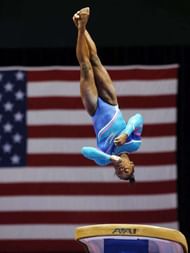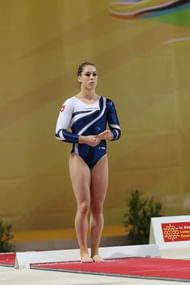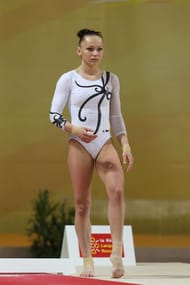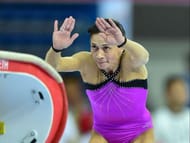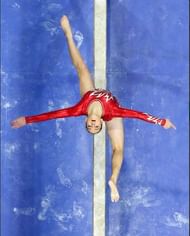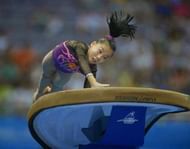Dipa Karmakar has done the incredible. She has made India look forward to an artistic gymnastics vault event. Tonight, Karmakar will compete with seven of the world’s best for the vault gold. But her success depends not just on how well she completes the Produnova but on how she is scored in it and how her opponents are scored in it.
The vaults are the fastest of the four apparatuses of artistic gymnastics. With no finely crafted combinations of elements to present on a floor, beam or a pair of bars, the vaults are the simplest when it comes to scoring.
The vault routine of a gymnast involves just two separate vaults to be executed one after the other. Due to its relative quickness, the vaults are a condensed experience and require the gymnast to deliver within a comparatively limited scope.
Vaults are scored for difficulty and execution. While the difficulty score is set by the FIG and remains a firm total the gymnast will get upon executing the vault, the execution score starts from 10, with each penalty deducting from the total of the two.
Dipa Karmakar scored a total of 14.850 in the vaults of the qualifying round. She stuck both her Produnova (15.100) and the Tsukahara (14.600) and ranked eighth. However, viewers might have noticed that both her vaults did not have traditionally neat landings. Her Produnova had a low finish from which she recovered and her Tsukahara was not a light stick either.
So why did Dipa score so well? Turns out that the intricate and newly designed Code of Points is structured to reward difficulty over perceived beauty of a routine. And Karmakar’s vaults were certainly difficult. We take a look at how the Code favours or goes against Dipa when it comes to her finals rivals.
Simone Biles
Living legend Simone Biles’s latest vaults were at the individual all-around finals. She won gold in the event and scored 15.866 in the vaults. Biles’s specialty is the Amanar – an above 6 rated D-score makes it one of the most dangerous and Biles’s superior sticking abilities make her a prime suspect for the highest possible score in the Amanar.
Except for one little glitch. Biles has the habit of crossing her toes while she is in the air. And as cruelly unforgiving as gymnastics can be, she loses 0.1 from her execution score each time for this. In recent competitions, Biles’s score has ranged between the high 15s to as high as 16.050.
Her execution score has remained a consistent (and extraordinary 9.7 in the past six times she performed on the vault at this Olympics.
Hong Un-Jong
The North Korean who beat Biles at the 2014 Nanning World Championships is one of the more real threats to Karmakar’s claim to a silver, because Hong, like the Indian gymnast is singularly devoted to the vault.
In 2014, she accomplished two very difficult vaults and managed to outdo Biles’s near-perfect execution scores by almost 0.8 points that Hong gained in difficulty scoring. This means, that like Dipa, Hong’s strength lies in difficulty and not execution.
This is something she certainly exploited in the Olympic qualifiers where she scored 15.683, besting her Beijing gold-winning total of 15.650. However, Hong has been keenly working on perfecting her execution scores and often reached the top 9s these days.
Giulia Steingruber
In the women’s individual all-around finals, Steingruber scored 15.366 on the vault and ranked 10th becoming the first Swiss woman to attain this high an all-around rank. This was already an improvement upon her 15.266 vault score in the qualifying round.
Steingruber is a versatile vaulter with a wide range in her command. While she has displayed an astonishingly clean Amanar in recent competitions, 2013 and 2014 saw her execute layout Rudis and Tsukaharas with equal measure of skill.
Unlike Hong and Karmakar, Steingruber keeps to vaults with relatively lower D-scores and instead makes up with her high 9 execution score. Virtually flawless, her execution scores (9.4 and 9.133) in the Olympics prelims have been almost a point more than Karmakar’s (8.1 and 8.6).
Maria Paseka
Russian Maria Paseka has already won a silver medal at the women’s team all-around and contributed to her team’s overall score of 176.688.
With a back injury persisting in into her journey to Rio, Paseka’s performance has swung from stellar to one where she incurred a 0.300 penalty on an Amanar in the qualifying round.
Paseka’s repertoire is notably similar to that of Biles – she too does an Amanar and a Cheng and both (depending on variations) have difficulty ratings within the 6 to 6.8 bracket.
However, in keeping with the inconsistency of her usually dependable performance, she dropped to a 14.950 in the women’s all-around competition from a 15.049 in the prelims on the vaults. Dipa, who usually does not perform either of these two skills could gain if Paseka falters and earns penalties tomorrow.
Oksana Chusovitina
Uzbekistan’s Chusovitina has by now stolen headlines for her return to the Olympics every four years since 1992. Responsible for introducing the non-layout Rudi vault, Chusovitina has never done any of the round-off, back handspring Yurchenko vaults which score comparatively lower in difficulty as they propel the gymnast to a higher height.
Instead, Chusovitina only does the front handspring (the kind that sets off the Produnova) and Tsukahara vaults.
All of this is to say that her vaults will correspond to the ones that Karmakar will possibly attempt. Her execution score in the prelim rounds, though, does not break into the 9 bracket and puts her total at 14.999 – which is very close to Dipa’s total.
In this hallowed list of vault finalists, Chusovitina is one whom Dipa has most recently beaten. At the Rio test events preceding the Olympics, Dipa won gold and Chusovitina won silver at the vault. It is the video and photographs of this medal ceremony that has been circulating as a misrepresented evidence of Karmakar’s apparent gold win at the Rio Olympics.
Shallon Olsen
The 16-year-old Canadian is an expert at the Rudi-Amanar succession of vaults – something she did with aplomb at the qualifying rounds, getting a total of 14.950.
A vertical growth spurt that led Olsen to grow taller by seven inches in the last two years has forced her to re-adjust all her gymnastics skills. However, at her very first Olympics, Olsen has proven to be a master of the Amanar and is the first Canadian artistic gymnast to successfully stick it at the Olympics.
She will likely attempt the Amanar followed by the Rudi at the finals, which means that unless her execution suffers, she will come very close to a perfect score.
Wang Yan
At 16, Wang Yan has already won Olympic bronze in the team all-around event and ranked sixth in the individual all-around in which she scored 14.633 at the vault.
In the qualifying rounds, Wang scored 14.949 at the vault with a penalty of 0.100 on her second vault that led her to miss out on an above 15 qualifying score.
More in the news for her small frame that pushes viewers to disbelief over her age, Wang has the advantage of it when it comes to lighter sticks. She tends to stick to vaults with difficulty ratings within 6.3, and her execution score is yet to reach the late 9s.
In a sport where minor wobbles, unsteadiness, a shoulder-length step upon landing and even mild ‘hesitation’ before performing a vault can cost points, there can be no doubt that Karmakar has a steep task ahead of her. If she wins a medal, it will be the end of a long journey for Dipa. If she does not, she will still remain one of the greatest gymnasts on the vault.
